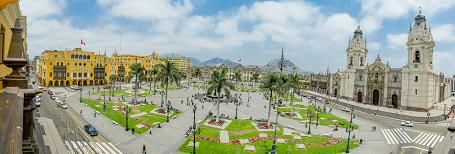Technology: A key component on the road from Lima to Paris
Negotiations for the new global climate deal are intensifying by the day and governments are convening in Lima, Peru for the last official political negotiations before the Paris Climate Conference in December 2015.

This year, the Parties discussed for the first time in the Convention’s history, substantive technical issues in the form of Technical Expert Meetings (TEMs) under the Ad Hoc Working Group on the Durban Platform for Enhanced Action (ADP). Policies and actions regarding renewable energy, energy efficiency, urban structures, carbon capture and storage, and methane and HFCs, etc. were debated between governments and other important stakeholders. Meetings were very welcomed events, where the leading companies and institutions from private sector and civil society were able to present their solutions and views on key mitigation and adaptation issues.
The general perception of those meetings was very positive. Governments learned about relevant technologies and successful policies, as well as about some challenges and barriers related to finance and technology transfer. In the end, there was overwhelming support for these meetings to be continued until Paris and even beyond.
Technology Mechanism ready to serve
Many participants referred to the fact that discussions should be more clearly linked to the existing Technology Mechanism of the UNFCCC, namely the Technology Executive Committee (TEC) and the Climate Technology Centre and Network (CTCN). Representatives of these bodies have indeed already contributed to the Technical Expert Meetings and provided status reports.
The assistance CTCN provides to developing countries is based entirely on a country-driven principle
Both the TEC and the CTCN stand ready to include the outcomes of the TEM meetings in their own work programs and actions. When working with the developing countries to respond to their climate technology-related requests, the CTCN can inform the National Designated Entities (the national CTCN focal points selected by each country) about relevant policy options, which could enhance the transfer and dissemination of climate technologies in their countries. As these policies have already been debated by the Parties, they enjoy large support among most countries. It is then for the country itself to choose appropriate options according to its national circumstances.
Let me emphasise here, that the assistance CTCN provides to developing countries is based entirely on a country-driven principle. That means that any developing country may submit a climate technology related request or question to the CTCN, and the Centre will mobilise experts from among its global network to provide specialist services (at no cost to the country), including:
- developing analytical tools, policies and plans;
- providing tailored capacity building; and
- facilitate linkages with countries or initiatives with valuable, relevant experience.
Requests for assistance can by conveyed by the NDE on behalf of a local, national or regional entity – be it an academic centre, NGO, private or public institution - as long as it is deemed relevant to a country’s national climate change strategy. CTCN is already working with over twenty developing countries to provide technology solutions, and more requests are arriving weekly. The themes of the requests correlate well with areas under discussion in the negotiations: assessing policies for energy efficiency; linking climate actions to urban air pollution; climate resistant land use in rural communities; climate proof waste management; and green cooling. Many of these technical assistance initiatives will lead to concrete climate investments with the support of financial partners such as the Global Environment Fund (GEF) and the regional development banks.
Climate Technology Network to convene all centres of excellences
But outcomes of the Technical Expert Meetings (TEMs) should also result in a more sustainable and long lasting impact on the structure of the climate convention and its negotiation processes. All of those who contributed to the dialogues between governments and stakeholders should systematically be engaged in the future negotiation processes beyond the Paris agreement. In 2010, the Parties in Cancun mandated that the CTCN facilitate a network of national, regional, sectoral and international technology entities, organisations and networks to support the work of the Convention’s Technology Mechanism.
We have begun to collaborate with numerous Climate Technology Network members, including international organisations such as the World Intellectual Property Organization (WIPO) and the Renewable Energy and Energy Efficiency Partnership (REEEP), national NGOs, and private sector entities. Many of the Network members actually serve as centres of excellence in the exact themes discussed at the TEM meetings. It is therefore natural, that further and more structured inputs from specialised organisations could be arranged through the architecture of the Technology Mechanism.
Accessibility to technology information
During recent meetings, many Parties expressed their concern that information on relevant climate polices as well as proven technical solutions should be made available, especially to developing countries, in an easily accessible manner. Some suggested a special web-based service to be launched.
The CTCN will launch the first phase of this online resource, ctc-n.org, during the Lima COP20
One of the three main services that the Parties have mandated the CTCN to deliver is a comprehensive online information service for developing country authorities. Thus, the CTCN will launch the first phase of this online resource, ctc-n.org, during the Lima COP20.
The information service serves as an easy, accessible platform for Parties, and guides them through relevant and objective climate technology information from multiple existing sources and providers. Naturally, the system also serves as an entryway to all CTCN services as well. I hope that those participating in the Lima COP will have an opportunity to familiarise themselves with this resource.
Future options for the Convention’s Technology Mechanism
For COP21 in Paris to be successful, and in order to respond with urgency to the technology challenges of climate change, we must move faster and work more extensively in our joint efforts for technology transformation. Signals from many developing countries in the negotiations already provide us with some direction. In providing technology assistance, we must be able to serve all countries in a language in which they can communicate.
We have recently launched a special programme to support least developing countries in building their capacity to assess and define their national climate technology needs
We need to build awareness of our service offerings so that countries can avail themselves of useful and relevant assistance. We need to understand and take into account endogenous technologies and their potentials. And we need to build and support capacities for climate technology transfer that are customised for local circumstances.
The CTCN has allocated considerable resources for convening different technological communities and stakeholders on a regional basis in order to learn from existing efforts and needs. Similarly, we have recently launched a special programme to support least developing countries in building their capacity to assess and define their national climate technology needs, so that they can best make use of the assistance of the CTCN and its many partners. Furthermore, we respond to assistance requests in all six UN languages in order to make it as easy as possible to access our services.
We now ask developing countries to come forward, utilise available services, encourage your academic, NGO, and private sector partners to join climate-oriented networks, and engage with initiatives, such as the CTCN, to contribute to our common and urgent effort.








